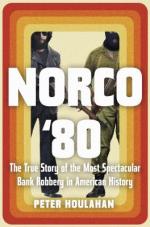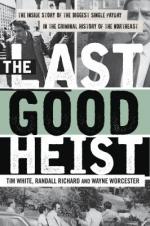June 20, 2019 | kasarak
It can be fascinating to read about what individuals will try to steal--perhaps less amusing if you are the bank teller who receives the note slipped under the glass.
Look below for titles on bank heists, shoot-outs, the resulting grisly deaths, and dreams of riches gone awry.
Norco '80 tells the story of how five heavily armed young men--led by an apocalyptic born-again Christian--attempted a bank robbery that turned into one of the most violent criminal events in U.S. history, forever changing the face of American law enforcement. Part action thriller and part courtroom drama,Norco '80 transports the reader back to the Southern California of the 1970s, an era of predatory evangelical gurus, doomsday predictions, megachurches, and soaring crime rates, with the threat of nuclear obliteration looming over it all.
In this riveting true story, a group of landscapers transformed into a murderous gang of bank robbers armed to the teeth with military-grade weapons. Their desperate getaway turned the surrounding towns into war zones. When it was over, three were dead and close to twenty wounded; a police helicopter was forced down from the sky, and thirty-two police vehicles were destroyed by thousands of rounds of ammo. The resulting trial shook the community to the core, raising many issues that continue to plague society today: from the epidemic of post-traumatic stress disorder within law enforcement to religious extremism and the militarization of local police forces.
On Aug. 14, 1975, eight daring thieves ransacked 148 massive safe-deposit boxes at a secret bank used by organized crime, La Cosa Nostra, and its associates in Providence, R.I. The crooks fled with duffle bags crammed full of cash, gold, silver, stamps, coins, jewels and high-end jewelry. The true value of the loot has always been kept secret, partly because it was ill-gotten to begin with, and partly because there was plenty of incentive to keep its true worth out of the limelight. It's one thing for authorities to admit they didn't find a trace of goods worth from $3 million to $4 million, and entirely another when what was at stake was more accurately valued at about $30 million, the equivalent of $120 million today. It was the biggest single payday in the criminal history of the Northeast. Nobody came close, not the infamous James "Whitey" Bulger, not John "The Dapper Don" Gotti, not even the Brinks or Wells Fargo robbers. The heist was bold enough and big enough to rock the underworld to its core, and it left La Cosa Nostra in the region awash in turmoil that still reverberates more than forty years later. Last Good Heist is the inside story of the robbery and its aftermath.
Attila Ambrus was a gentleman thief from Transylvania, a terrible professional hockey goalkeeper - and preferred women in leopard-skin hot pants. During the 1990s, while playing for the biggest hockey team in Budapest, Ambrus took up bank robbery to make ends meet. Arrayed against him was perhaps the most incompetent team of crime investigators the Eastern Bloc had ever seen: a robbery chief who had learned how to be a detective by watching dubbed Columbo episodes, a forensics officer who wore top hat and tails on the job, and a driver so inept he was known only by a Hungarian word that translates to 'Mound of Ass-Head'. BALLAD OF THE WHISKEY ROBBER is the completely bizarre and hysterical story of the crime spree that made a nobody into a somebody, and told a forlorn nation that sometimes the brightest stars come from the blackest holes. Like The Professor and the Madman and The Orchid Thief, Julian Rubinstein's bizarre crime story is so odd and so wicked that it is completely irresistible...
For the first time, two of the people who followed the story from the beginning--Jerry Clark, the lead FBI Special Agent who cracked what became known as the Pizza Bomber case, and investigative reporter Ed Palattella--tell the complete story of what happened on August 28, 2003.
In the suburbs of Erie, Pennsylvania, a pizza delivery man named Brian Wells was accosted by several men who locked a time bomb around his neck. They then ordered him to rob a bank. After delivering the money, he would receive clues to help him disarm the bomb. It was one of the most ingenious bank robbery schemes in history, known as Collarbomb by the FBI. It did not go according to plan.
Wells, picked up by police shortly after the robbery, never found the clues he needed. Investigating the crime after his grisly death, the FBI soon discovered that Wells was not, in fact, an innocent victim. He was merely the first co-conspirator to fall in a bizarre trail of death following the crime...
When it comes to violent crime, the Las Vegas cops and casino owners thought they had seen it all. But they had never witnessed anything like Jose Vigoa.
Born in Cuba, a child of Fidel Castro’s revolution, Vigoa used his quick wits and quicker fists to trade a life of poverty and desperation for one of danger and adventure as a Soviet-trained special forces officer. Battle hardened in the killing fields of Afghanistan and Angola, Vigoa won a reputation for toughness, bravery, and coolness under fire. A brilliant military career lay ahead of him.
Then, in 1980, Castro opened Cuba’s floodgates in the Mariel boatlift, and Vigoa, like so many of his countrymen and -women, braved chaos and hardship to start a new life in America’s promised land. But involvement with the drug trade brought his dreams crashing down. Years of prison followed.
On his release, Vigoa was determined to take revenge on what he perceived as the corrupt power structure of Las Vegas. On September 20, 1998, the former Spetsnaz lieutenant launched what would be the most audacious and ruthless series of high-profile casino and armored car robberies that Las Vegas had ever seen. In a brazen sixteen-month-long reign of terror, he and his tightly disciplined crew would hit the crème de la crème of Vegas hotels: the MGM, the Desert Inn, the New York-New York, the Mandalay Bay, and the Bellagio. They struck hard and fast, then vanished without a trace. Millions of dollars were stolen. Two brave men were gunned down in cold blood; others were wounded. And yet the robberies were so well planned and executed that the police–“the stupids,” as Vigoa contemptuously referred to them–were all but helpless.
Not Lt. John Alamshaw. The twenty-three-year veteran, in charge of robbery detectives, was not giving up so easily. For him, Vigoa’s rampage was a personal affront. And he would do whatever it took, even risk his badge, to bring Vigao down.
With exclusive access to all the major players, including Vigoa and Alamshaw, veteran journalist and network producer John Huddy is the perfect man to tell the gripping never-before-told story of this harrowing true-crime drama that will leave readers breathless.
The flesh-and-blood story of the outlaw lovers who robbed banks and shot their way across Depression-era America, based on extensive archival research, declassified FBI documents, and interviews The daring movie revolutionized Hollywood-now the true story of Bonnie and Clyde is told in the lovers' own voices, with verisimilitude and drama to match Truman Capote's In Cold Blood.Strictly nonfiction-no dialogue or other material has been made up-and set in the dirt-poor Texas landscape that spawned the star-crossed outlaws, Paul Schneider's brilliantly researched and dramatically crafted tale begins with a daring jailbreak and ends with an ambush and shoot-out that consigns their bullet-riddled bodies to the crumpled front seat of a hopped-up getaway car.Bonnie Parker and Clyde Barrow's relationship was, at the core, a toxic combination of infatuation blended with an instinct for going too far too fast. The poetry-writing petite Bonnie and her gun-crazy lover drove lawmen wild. Despite their best efforts the duo kept up their exploits, slipping the noose every single, damned time. That is until the weight of their infamy in four states caught up with them in the famous ambush that literally blasted away their years of live-action rampage in seconds. Without glamorizing the killers or vilifying the cops, the book, alive with action and high-level entertainment, provides a complete picture of America's most famous outlaw couple and the culture that created them.





